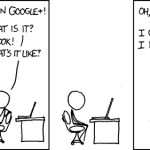
March 10, 2017
Teach STEM Every Day
 STEM is the acronym for Science, Technology, Engineering, and Mathematics. These four topics cover every aspect of our life. Science is our natural world, from the land we live on to the oceans and space we aspire to visit. It’s the weather that changes our picnic plans to the natural disaster that destroyed a town in our own state. Technology includes the iPads toddlers play on, the smartphones we use to guide our days, the apps that turn our lights on and off–or start our car. Engineering is why traffic flows smoothly on crowded roads and why bridges survive despite massive loads of trucks, and is the foundation for much research into global warming and alternative energy. Mathematics happens everywhere–at the grocery store, the bank, the family budget, the affirmative nod from parents to update a child’s computer to their agreement to add apps from the app store.
STEM is the acronym for Science, Technology, Engineering, and Mathematics. These four topics cover every aspect of our life. Science is our natural world, from the land we live on to the oceans and space we aspire to visit. It’s the weather that changes our picnic plans to the natural disaster that destroyed a town in our own state. Technology includes the iPads toddlers play on, the smartphones we use to guide our days, the apps that turn our lights on and off–or start our car. Engineering is why traffic flows smoothly on crowded roads and why bridges survive despite massive loads of trucks, and is the foundation for much research into global warming and alternative energy. Mathematics happens everywhere–at the grocery store, the bank, the family budget, the affirmative nod from parents to update a child’s computer to their agreement to add apps from the app store.
Every corner of every life includes STEM, which explains the increasing interest in STEM-educated students to fill the nation’s jobs. According to the U. S. Department of Commerce, STEM occupations are growing at 17%, while other occupations are growing at 9.8%. According to the Bureau of Labor and Management:
… jobs in computing and mathematics are projected to grow by 20 percent.
Significantly, STEM degree holders have a higher income even in non-STEM careers. Experts like Dr Kamau Bobb may say that students trained in STEM subjects think critically, develop creative solutions, solve problems rather than look to others for solutions, and create logical processes that can be duplicated in all parts of their life. STEM-trained students understand how to look at the forest and find the particular tree.
Sadly, K-12 education standards and curricula do not prepare students for STEM challenges. For some reason I don’t understand, too many educators shy away from hard facts and lean toward reflection and reaction. Common Core addresses that with their focus on college and career ready, but the huge pushback against these Standards (justified or not, depending upon which side you’re on–we won’t get into those here) may derail their approach. For reasons that can be closely aligned with a lack of the STEM-related skills, American students consistently score less year-to-year and less than other nations on measures of science and math. Many immigrants with strong math and science skills are warmly accepted to not just the US, but many other western nations.
Educators can turn this decline around with five mindshifts:
- Project the attitude that science and math are fun. Elementary-age students think this is true, but something happens between 4th and 8th grade. They begin to shy away from the academics they used to love. When you talk about math, science, engineering, or technology, add excitement to your voice. Act like you enjoy it so students will.
The problem is not that there are problems. The problem is expecting otherwise and thinking that having problems is a problem. —Theodore Rubin
- Never act like these topics are difficult, that certain students will not like them. In truth, they aren’t difficult–they merely use different parts of the brain — a different skillset — than many students are used to.
There is a great difference between worry and concern. A worried person sees a problem, and a concerned person solves a problem. —Harold Stephens
- Embrace the concrete nature of answers in STEM topics. Educators like to avoid what is often considered a right-wrong trap. They don’t want students to feel that if someone is right, someone else is wrong. But there is only one answer when adding two numbers or discussing the make-up of an element. Let students know that’s OK.
Success consists of going from failure to failure without loss of enthusiasm. —Winston Churchill
- Don’t let students see you get frustrated when you can’t solve a problem in the first ten seconds. Keep at it. Don’t call for help. Don’t quit. Model for them how you address problem-solving.
It’s not that I’m so smart, it’s just that I stay with problems longer. —Albert Einstein
- Revel in that feeling of accomplishment that comes with doing the impossible–finding the answer to a calculus formula (or division problem) or programming a robot to walk across the room.
Once everyone agrees STEM lessons are spectacular, try one of these four projects:
Coding
Coding uses the vehicle of programming to teach students creativity and logic, to be problem-solvers and critical thinkers. It can be taught via HTML gobble-di-gook or drag-and-drop widgets. Thanks to Hour of Code, coding has gone mainstream in classrooms across the world. Depending upon the option you pick (here’s a list of about a hundred coding sites for grades K-8), you can ratchet up or tamp down the geek factor, add more or less math, use a digital device or not, and take a few minutes to a few weeks.
C-STEM Studio
C-STEM Studio is a curriculum and turn-key solution for teaching science, technology, engineering and mathematics through computing and robotics. This web-based scalable program is available for elementary through high school students and can last anywhere from four weeks to a year.
Classroom Architect
The classroom environment is very important to students. The size of the classroom and interior areas, the colors of the walls, the type of furniture and flooring, the amount of light, and the room arrangement all influence how students learn. Use the free, no-login-required Classroom Architect to remind students of the part architecture and engineering plays in the success of their learning. Let them experiment with the classroom layout without any heavy lifting!
Through My Window
Through My Window is a free multi-media engineering curriculum for grades 4-8. It pulls students into a world filled with stories, mysteries, explorations, and adventures. It’s a place where engineering isn’t about building bridges—it’s about asking questions, thinking deeply, and building a community of learners. It’s where engineering becomes something all kids can do.
***
These are just a start. If a story students read inspires a STEM activity, instead of skipping to the next check box in your curriculum, scaffold that student interest into a lesson that will be their WOW moment for the month–or year. Yeah. STEM can do that.
More on STEM
Keyboarding and the Scientific Method
Common Core: A Lesson Plan for STEM (on Bridges)
Jacqui Murray has been teaching K-8 technology for 15 years. She is the editor/author of over a hundred tech ed resources including a K-8 technology curriculum, K-8 keyboard curriculum, K-8 Digital Citizenship curriculum. She is an adjunct professor in tech ed, CSG Master Teacher, webmaster for four blogs, an Amazon Vine Voice book reviewer, CAEP reviewer, CSTA presentation reviewer, freelance journalist on tech ed topics, and a weekly contributor to TeachHUB. You can find her resources at Structured Learning. Read Jacqui’s debut tech thriller, To Hunt a Sub.






